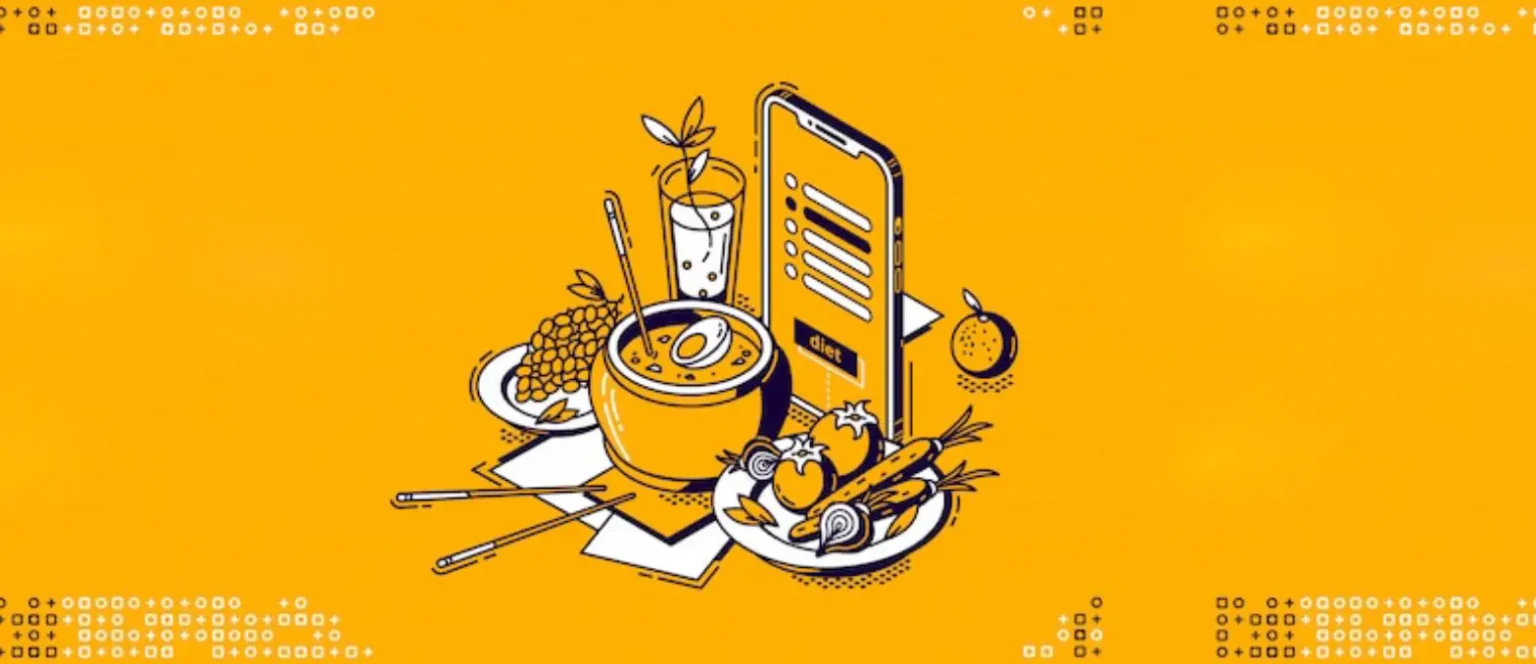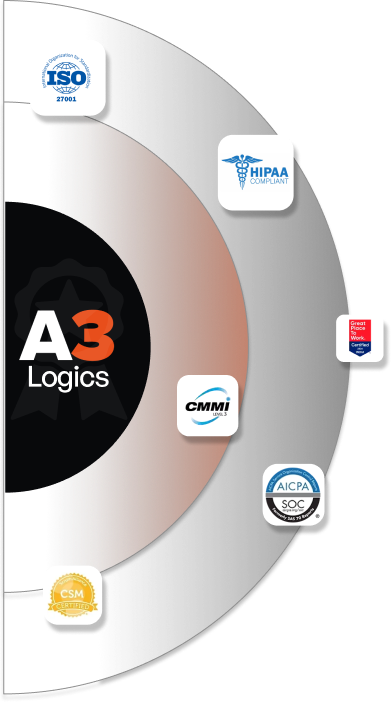Medicine Delivery App Development: A person might need medicine at any hour of the day (or night). Rushing to a pharmacy, especially at odd hours or when you are busy, isn’t always an option. That’s where a medicine delivery app steps in as a real game-changer. It brings crucial medicines to customers’ doorsteps.
Considering how enormous the online medicine delivery market is (something that we’ll dive into in just a while), you have an opportunity where you can deliver timely care to those in need and at the same time unlock strong revenue potential. It is indeed a great time to invest in medicine delivery app development.
Now that you have won half the battle by validating this noble and lucrative market opportunity, let’s dive into how to build and scale your medicine-delivery app so that you can win the other half.
Table of Contents
What is a Medicine Delivery App?
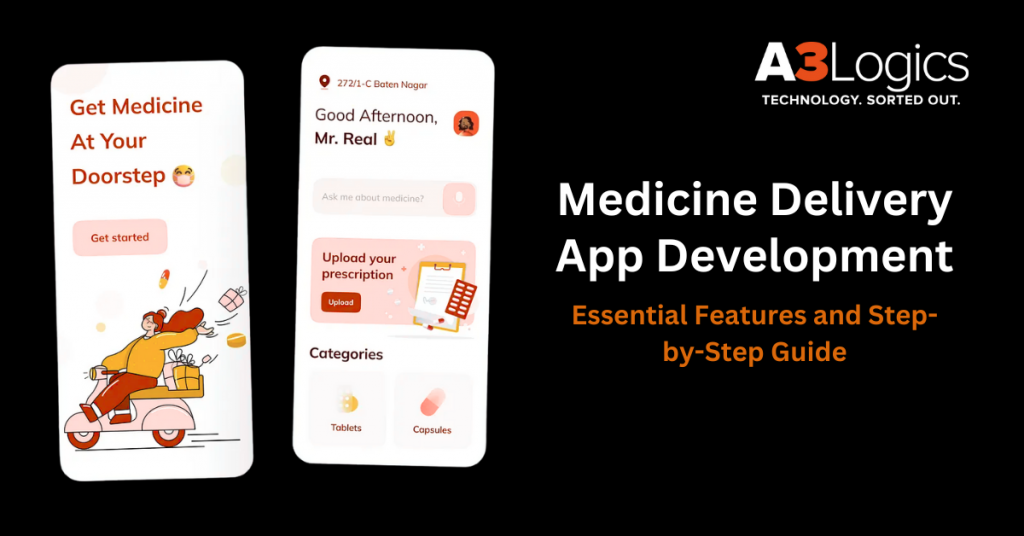
Before we get into the various aspects of medicine delivery app development and how much it will cost, let’s first understand what a medicine delivery app is –
A medicine delivery app is a mobile application that enables users to order prescription and over-the-counter medications, along with several other healthcare products, right at their doorstep. They needn’t leave their house and visit a physical pharmacy to order medicines or pay for them.
Now, that’s just one of the aspects when considering online medicine delivery app development. Let’s explore this opportunity and understand how you can develop a successful medicine-delivery app.
Market Trends & Statistics for Medicine Delivery Apps in 2025
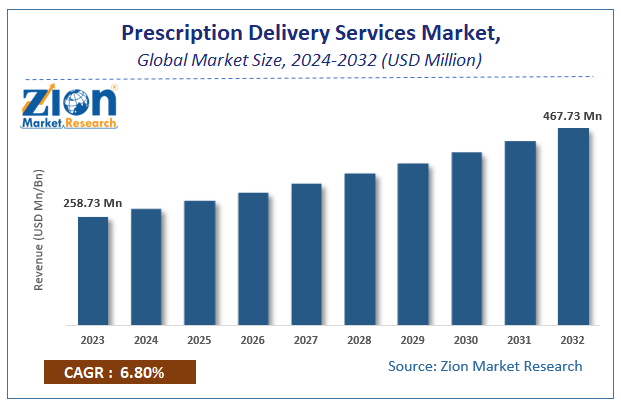
- By 2028, the global digital health market is expected to cross $275 billion.
- The online pharmacy market is projected to reach $97.18 billion by 2025 and $130.50 by 2029
- The global medical apps market had over 3,50,000 apps in 2021 and is estimated to grow 28.4% by 2030.
- The online pharmacy is projected to generate $97.18 billion in revenue in 2025, with average revenue per user (ARPU) reaching $95.16
- The online pharmacy segment of the digital health market is expected to increase continuously by 367.3 million users between 2024 and 2029.
- The United States leads the medicine delivery app industry and is projected to grow at CAGR of 14.7% from 2024-2031.
Workflow: How Do Medicine Delivery Apps Work?

> User Registration/Login
It starts with users downloading the app, creating an account, and providing all the necessary details for order placement and delivery. In some instances, your app might require users to upload doctors’ prescriptions for certain medications.
> Upload Prescription or Search for Medicines
Users can either search for a medicine and order it online, or if it isn’t an over-the-counter medicine, they may have to upload the doctor’s prescription. After the prescription is uploaded, the app verifies it, and then the user can add medicine to their cart and make payments.
> Prescription Validation by Licensed Pharmacist
To adhere to medical regulations and protocols during medicine delivery app development, it is of utmost importance that your app has a functionality where a licensed pharmacist validates prescription.
Here, the app has checks in place to ascertain whether a registered medical practitioner has generated the prescription. Furthermore, the visit date and medication duration are checked to determine if the prescription has expired. Some apps also check if the quantity of the medicines ordered matches the prescription.
> Add Medicines to Cart & Proceed to Checkout
Once the prescription is validated and it is confirmed that the aforesaid medicines are in stock, customers can proceed with adding the medicines that they wish to order to their shopping cart. They can verify the quantity and the price and finally make an online payment using a desired payment method.
> Auto-Assignment of Nearby Pharmacies
Once the user has placed an order, the delivery app connects to the closest pharmacy with the requested medicines. Now, here comes another important aspect that should be kept in mind during online medicine delivery app development, you also need to integrate systems for managing pharmacy inventory in order to handle orders and monitor stocks in real time. The same features also let customers schedule reminders for refills while they are placing orders.
> Order Confirmation from Pharmacy
Sometimes, the order isn’t confirmed immediately after the user uploads a prescription. The app first confirms from the vendor if the requested medicines are in stock. Information about the unavailability of any requested medicines is communicated to the user via SMS and email. Plus, the app also considers prescription validation, and only after the validation criteria and stock availability are confirmed is the order confirmed from the pharmacy.
> Secure Online Payment or Cash on Delivery
Once the pharmacy confirms that the requested medicines are in stock, the user can make payments via two methods: secure online payment gateways or cash on delivery. Secure online payment options include credit/debit cards, UPI, and digital wallets, while cash on delivery gives a user the option to pay in cash when, for instance, they don’t have access to online payment methods or if they are hesitant to share financial information online.
> Medicine Packing & Dispatch
Once the payment is received, the pharmacy prepares and packages the order. The pharmacy then assigns the order to the nearest rider. The rider then picks up the order and heads to deliver the order at the address provided by the user.
> Real-Time Order Tracking
When providing medicine delivery app development solutions, ensure that the app also has real-time order tracking features. This way, users can track the status of their order in real time. They can check their medicine’s estimated arrival time, which can be useful if the medicine is urgently required. Many apps even show the live location of the delivery person and a visual representation of the delivery progress.
> Doorstep Delivery of Medicines
One of the highlights of the development of an online medicine delivery app is that customers can get medicines at their doorstep at any time and anywhere using the app. The users needn’t travel out of their house to visit a pharmacy to purchase medicines.

Why Investing in Medicine Delivery Apps in 2025 is a Game-Changer
The demand for medicine delivery apps is on the rise. In the wake of recent global events, ordering medicines from the comfort of home is a game changer both for people and for medicine delivery app development companies. Here’s why investing in medicine delivery app development can be a lucrative option –
> Rapidly Growing Market Demand
The online pharmacy market is expected to grow rapidly. There is projected to be a significant revenue increase and user penetration, considering that a growing number of users find it more convenient to order and purchase medicines online instead of visiting a physical pharmacy.
> Increased Healthcare Digitization
Everything related to medicine is moving online—from telemedicine and e-prescriptions to patients and providers. Medicine delivery apps fit perfectly into the digital ecosystem. This implies that by investing in this ecosystem, you can participate in the healthcare revolution and generate a substantial amount of revenue.
> Efficiency Through AI & Automation
AI and automation are transforming inventory management, logistics, personalized medicine recommendations, and customer service. These revolutionary technologies enhance user experience, reduce operational costs, and improve order accuracy.
> First-Mover Advantage in Emerging Regions
Though the scope of medicine delivery apps is huge, some regions lack robust online pharmacy infrastructure. You can identify these regions and proceed to medicine delivery app development to gain a first-mover advantage.
This means that by seeking the services of a seasoned mobile app development company and getting a medicine delivery app developed, you can establish a dominant brand. Furthermore, as the first mover, you can build trust, set standards, and capture a loyal customer base.
> High User Adoption Rates
More and more users are inclined towards ordering medicines through medicine delivery apps for the simple reason that they offer the convenience of sitting at home and purchasing every possible medicine. This has led to the high adoption of such apps across all age groups.
Business Models for Medicine Delivery Apps
The business model you choose when developing a medicine delivery app depends on the platform, market, and services you wish to offer your users. Let’s discuss some of the popular business models for medicine delivery apps –
1. Inventory-Based Model
This model entails an online prescription delivery business model. Here, pharmaceutical products are stored and sold directly to clients. This means that companies store their stock of medicines and drugs in their warehouses and ship the products directly to users when they place an order. The model also requires the business to manage inventory, i.e., keep track of stock and replenish it once it is nearing its end.
2. Marketplace (Aggregator) Model
In the context of medicine delivery app development, the aggregator-based model involves the app acting as a platform where multiple pharmacies can connect with users (customers). From a single interface, users can browse medications from various pharmacies. The app doesn’t need to manage its own inventory.
3. Hybrid Model
In this model, traditional pharmacies can maintain their offline presence, i.e., a physical store, and an online presence. For the latter, they can seek medicine delivery app development services, offering customers the functionality to browse their medicines from their website or mobile app.
Must-Have Features in a Medicine Delivery App

When developing a medicine delivery app, here are the must-have features you should plan to integrate. These ensure that the app meets customers’ expectations.
1. User Panel (For Customers)
> Secure Login & Profile
This is how a user will log in to the medicine delivery app. They would first need to create an account using their email, social media, or phone. Using the same, they can log into the app. Once logged in, they can proceed with other tasks such as uploading prescriptions, browsing medicines, making transactions, etc.
> Smart Search & Prescription Upload
The app should have a smart search capability, where users can zero in on the most appropriate medicines based on criteria like symptoms, user behavior, previous orders, etc. It is also recommended that the app give AI recommendations to quickly find medicines.
> Cart, Scheduling, & Subscriptions
Users can add medications to their cart. Once they have done that, they can do various things. They can either proceed and buy the items in the cart or schedule a purchase at a designated time in the future. The app can also feature subscriptions where users can set up recurring orders for medications needed regularly.
> Multiple Payment Options
In the user panel of a medicine delivery app, multiple payment options include digital wallets, credit/debit cards, UPI, and potentially cash on delivery. Some apps also include the option of insurance. This way, users can partially or fully cover their medication costs through their health plans, thereby increasing access and affordability.
> Real-Time Tracking & Order History
This app feature lets users track their order’s status in real time. For instance, whether it is confirmed, packaged, dispatched, or out for delivery. Right from the moment the order is placed to the moment it reaches the user, the user can get live updates of the status of their order on their app.
> In-App Support & Notifications
Through this section, users can raise issues regarding their orders, prescriptions, delivery, payment, etc. In such instances, a customer support executive or a pharmacist will help the user out. With the integration of notifications, customers can be kept informed about order updates, account updates, password changes, and security alerts.
2. Pharmacy Panel (For Partner Pharmacies)
> Secure Access & Profile Control
The medicine delivery app consists of sensitive user data. As a responsible app, only authorised and licensed personnel should be allowed to access sensitive data and manage pharmacy profiles, user roles, and data encryption to protect patient information.
> Inventory & Prescription Management
This section of the pharmacy panel helps pharmacists monitor their stock levels based on how quickly medicines are being sold. Pharmacists can monitor stock levels, restock as needed, and set low-stock alerts.
> Order Handling & Dispatch Updates
Via order handling and dispatch updates, pharmacists can track the orders at hand, keep account of the orders that have been dispatched and those that have been paid for, and update customers regarding the progress of their orders.
> Customer Interaction & Reports
This section allows for a constant communication stream between pharmacists and users. The pharmacists can communicate with customers regarding order status, medicine requirements, and other information. They can address any incoming customer-related queries and inform customers regarding their orders. The section also provides pharmacists valuable insights that they can use to make business-related decisions. For example, conduct targeted promotions, track stock levels, access data on pharmacy performance, etc.
> Promo & Offer Management
These tools and features in a medicine delivery app can help pharmacists track discounts, promotional campaigns, and loyalty programs. Integrating these tools is intended to help pharmacists attract more customers and boost sales.
3. Delivery Partner Panel (For Delivery Agents)
> Registration & ID Verification
This section requires a delivery partner to create an account and upload the necessary identification documents to register on the platform. Once all the required documents are uploaded, the designated team or the admin panel ascertains the delivery partner’s genuineness.
> Manage Assigned Deliveries
This section allows delivery agents to view, track, and manage the orders they have been assigned for delivery. The section also includes details like customer information, order status, and delivery address.
> GPS Navigation & Delivery Confirmation
Through GPS navigation and delivery confirmation sub-panel, the delivery partners can get real-time route guidance and find the exact location of customers where the medicines must be delivered. Also, once delivery partners are out for delivery, the customer receives an OTP on their smartphone via SMS or email that they must tell the delivery partner, only after which the delivery will be considered complete.
> Earnings Dashboard
The earnings dashboard provides delivery agents with a clear and concise overview of their financial performance in terms of aspects like deliveries completed, income generated, any pending payouts, and past delivery history.
> Push Notifications & Communication Tools
Delivery partners are notified as soon as orders are assigned to them via push notifications and communication tools. Delivery agents are alerted about new orders and order status updates such as “order accepted”, “out for delivery”, “delivered”, etc.
4. Admin Panel (For App Owner/Admin)
> Centralized Management Dashboard
In simple words, this is a central place or web-based interface from where app admins can handle the various aspects of the app – inventory management, order tracking, user information, pharmacy information, etc. The dashboard gives admins a holistic view based on which they can further make decisions or solve issues. This is also the place from where admins can modify app content such as promotional material, product descriptions, etc.
> Product, Order & Payment Controls
It allows admins to manage medicine listings, track and process customer orders, and oversee all payment transactions. The section also helps maintain appropriate inventory levels to fulfill orders regularly. The section also helps monitor payments in real-time (customer payments, payments to delivery partners, etc)
> Real-Time Analytics & Reports
The medicine delivery app’s admin panel provides real-time analytics and reports that provide admins with immediate insights into key performance indicators such as delivery metrics, sales, orders, and customer behavior. Using these, admins can improve operational efficiency and enable data-driven decision-making.
> Dispute Resolution & Support Handling
Customers, pharmacists, and delivery agents may raise queries and complaints. One important feature of medicine delivery app development is including a system for dispute resolution and support handling. This promptly addresses issues raised by any party.
> Marketing Tools & Compliance Monitoring
Administrators can create and manage promotional campaigns, such as coupons, discounts, and special offers, to drive sales, boost user engagement, and help retail customers. They can also optimize the app’s content and structure it for search engines to improve user acquisition and visibility. The compliance monitoring tools encrypt prescription and customer data to ensure adherence to GDPR, HIPAA, and regional healthcare regulations.
Advanced Features to Stay Ahead of the Competition
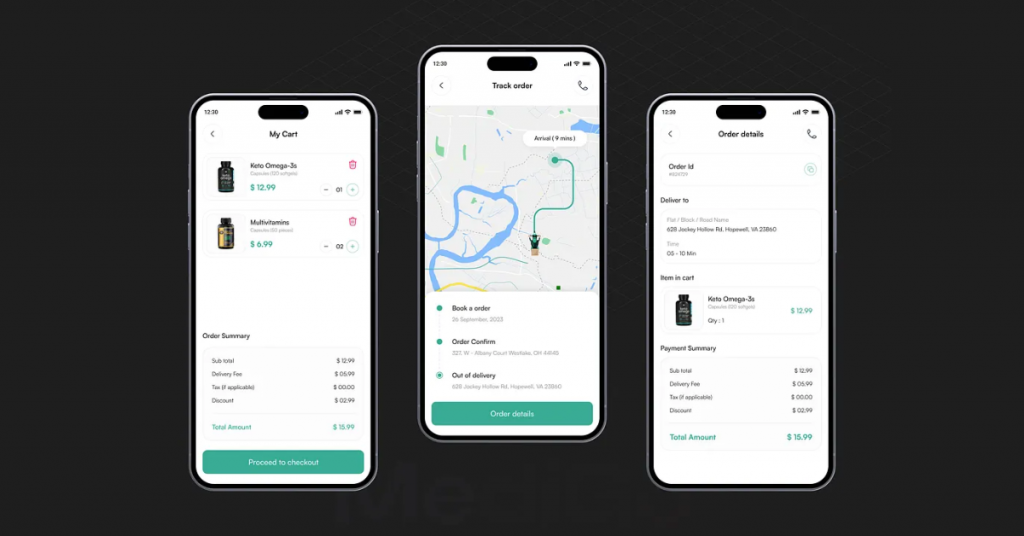
When you seek medicine delivery app development services from a seasoned company, you can expect the integration of advanced features like –
1. AI-Based Medicine Recommendations
The AI-powered intelligent search suggests medicines and healthcare products based on factors like symptoms, user behavior, previous search/ purchase history, subscription, and various other factors.
2. Telemedicine Integration
While building a telemedicine app is altogether a different game, you can also include a feature where patients can talk to health professionals and get their prescriptions delivered directly via the app.
3. Voice Search & Ordering
Instead of using the smartphone’s keypad to enter the name of medicines or search for them, the user can instead use voice commands to search for medicines and other health-related queries.
4. Barcode Scanning for Quick Lookup
Users can scan barcodes on the back of medication packages to find accurate details about a medication. This feature can reduce the chances of ordering the wrong medicine.
5. Live Stock from Nearby Pharmacies
This advanced feature can help users see the real-time inventory levels of medications at nearby pharmacies. This allows them to order medications that are actually in stock.
6. Digital Health Record Management
A medicine delivery app can integrate with an EHR (Electronic Health Records) / EMR (Electronic Medical Records) system, allowing users to access and manage their health data directly from within the app. This includes records like medical histories of allergies, lab results, medications, prescriptions, etc.

Global Success Stories of Medicine Delivery Apps
> Capsule Pharmacy
The Capsule pharmacy app is a digital pharmacy that provides same-day, free delivery of prescription medications within a specified area. With the app, users can request refills, manage their prescriptions and chat with pharmacists regarding the status of their orders. The app also facilitates coordinating copays with insurance.
One great feature of the app is that it enables doctors to e-prescribe medications directly to Capsule.
> PillPack by Amazon Pharmacy
Amazon acquired PillPack in 2018 for $753 million and used the latter’s expertise in online pharmacy and medication delivery. The platform delivers pre-sorted personalized medication packets delivered to patients’ doorstep.
One of the best aspects of this platform is that it organizes medicines into daily packets to help patients manage their medication schedule. PillPack aims to make pharmacy experience more convenient and safer for patients.
> Walgreens App
It is a free mobile app that helps users manage their prescriptions, shop for items and access various Walgreens services. To refill prescriptions medications, users can scan the prescription barcode or enter the information. The app allows users to track the status of their prescriptions; alerting them if they are ready for pickup.
Using the app, the users can also set reminders for their medications as well. The app also provides telemedicine services where users can connect with healthcare providers and doctors.
Step-by-Step Process to Build a Medicine Delivery App
Step 1: Conduct Market Research & Define Goals
Like any other app, medicine delivery app development isn’t one-size-fits-all. Conduct thorough market research and first identify who your target users are, whether they are children, adults, elderly, people with limited mobility, or others. Based on this, define particular goals. For example, you might want to tackle the issue of a few nearby pharmacies, engage with local communities, conduct surveys, etc.
Step 2: Select Business Model & Ensure Compliance
Select a business model that fits your target audience and goals at this stage. You can refer to the business models we have discussed in this post. Also, explore how you can generate revenue from your medicine delivery app. At this stage of development, you should also pay special attention to data privacy regulations, healthcare laws, prescription rules, and other legalities.
Step 3: Design & Develop Frontend & Backend
Select an apt tech stack for front-end and back-end development. For instance, you might want to choose Express.js and Node.js for notifications and the server. Firebase and MySQL are two of the preferred choices for handling the database. In case your goal is to develop a cross-platform medicine delivery app that can work well on multiple operating systems (Android, and iOS), React Native can be a great choice.
Step 4: Integrate Core + Advanced Features
Integration with delivery services, pharmacies, and payment gateways is crucial for a seamless user experience and also for the success of your medicine delivery app. Let’s have a look at some key integrations –
- Delivery Service Integration
Partner with logistics providers to enable the timely and efficient delivery of medications.
- Pharmacy Integration
Connect with pharmacy to process orders, manage inventory, and prompt medication dispensing.
- Integrate Secure Payment Gateways
To facilitate transactions, integrate secure payment gateways.
Apart from the above integrations, include –
- Systems to validate the authenticity of the prescriptions
- Telehealth services allow users to consult doctors and get prescriptions.
Step 5: Test, Launch on Platforms, & Continuously Improve
Before launching the app, test it thoroughly to identify and address any potential issues that might hamper user experience. During the testing phase, focus on performance, security, and functionality testing.
Next, the question arises: On which platform should the app be released? While cross-platform apps are in trend, your platform selection should be based on your business goals and target demographics. Additionally, you can conduct a soft or phased launch to test whether the app is scalable.
Lastly, even after the app is launched, continuously monitor metrics like user engagement, error rates, etc., analyze user feedback to improve the app; and release new features regularly.

Recommended Tech Stack
In the previous section, we discussed the kind of tech stack you might consider for developing a medicine delivery app. Here’s a breakdown of the technologies that could serve as a strong foundation for your medicine delivery app development –
- Frontend: React Native / Flutter, React.js
- Backend: Node.js with Express.js
- Database: MongoDB
- Cloud Hosting: Firebase / AWS
- Payments: Stripe, Razorpay, PayPal
- APIs & Integration: Google Maps API, FCM (Firebase Cloud Messaging)
Monetization Strategies for Medicine Delivery Apps
As a company wanting to create a medicine delivery app, you may wonder how you can generate revenue through an app. Let’s discuss some of the popular monetization strategies for medicine delivery apps –
> Commission on Orders
In this model, the app acts as a platform to connect pharmacies with customers and charges a commission fee for every sale made through the app.
> Subscription Plans
Through a subscription plan, your medicine delivery app offers users delivery services or discounts in exchange for a recurring subscription fee, improving customer loyalty and creating a steady income stream.
> Featured Listings for Pharmacies
Your medicine delivery app can act as a platform where pharmacies can feature their brand on your app to boost visibility and attract more customers. You can charge them for the same.
> Delivery Charges
Here, you can schedule or expedite the deliveries of users’ requested medicines for additional fees.
> In-App Advertisements
This is a revenue generation model in which a medicine delivery app can integrate ads from pharmacies, pharmaceutical brands, and other healthcare businesses for a certain fee. These ads can be promotional, brand awareness, or affiliate ads.
Cost Breakdown to Build a Medicine Delivery App
1. UI/UX Design
Your medicine delivery app development cost may change depending on how complex the layout and user interface is. A more intricate custom design filled with animations can prove to be costlier as it takes more time and effort.
2. Frontend & Backend Development
Both the front end and back end form the app’s core. Multiple user roles, third-party integrations, and complex features can significantly increase the cost of the app. On the other hand, a simple UI and basic functions would lower the cost. As for back-end development, tasks like API, database setup, and server logic can add to the cost. However, they may be necessary if security, scalability, and real-time handling is a priority.
3. Real-Time Features (Tracking, Notifications)
Real-time features like tracking and notifications require more complex backend systems and integration with GPS services. They further require robust infrastructure to handle real-time updates and data flow.
4. Payment Gateway Integration
Integrating a secure payment gateway adds to the development cost due to the need for security measures, specialized coding, security measures and potential licensing fees.
5. QA Testing & Deployment
Even though QA testing and deployment add to the upfront expenses, it saves post-launch issues by identifying and fixing bugs efficiently. Furthermore, it can help reduce the cost of reworks and delays.
6. Ongoing Maintenance & Updates
Now that you have a fair idea of the factors that can impact your medicine delivery app development, here’s the real cost of developing mobile apps.
Conclusion
The path to developing medicine delivery apps can be challenging, but eventually, the app you’ll develop will be revolutionary. You’ll indeed come up with a platform with which users will be able to access all kinds of medicines at their doorstep.
In that endeavor, we have created a comprehensive guide that touches upon various aspects, such as the app development process, the cost of medicine delivery app development, the tech stack needed, and others.
Even if you have the noble idea of developing the medicine delivery app but lack resources, worry not! You can always partner with a custom mobile app development company that will take into account all your goals and use their skills to bring your concept to reality.



